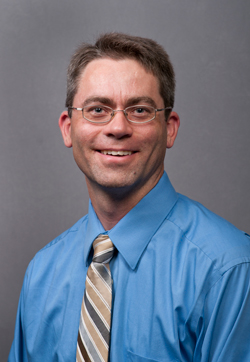ALBUQUERQUE, N.M. — Sandia researcher Greg Nielson is “one of the 10 most promising young scientists working today,” says Popular Science magazine.
Nielson garnered one of the magazine’s “Brilliant 10” awards for helping lead the Sandia effort to create solar cells the size of glitter.
Past Brilliant 10 honorees have gone on to win the Fields Medal (considered the Nobel Prize of mathematics) and MacArthur Foundation “genius” awards. Nielson and the other 2012 award winners will be featured in the October issue of Popular Science, available in late September.
“Greg Nielson and his team have created a new class of photovoltaic technology,” said the Sandia application in support of Nielson’s nomination. “The tiny pieces, each the size of a piece of glitter, sharply contrast with the so-called ‘bricks’ used by the photovoltaic industry.”
Sandia Labs Director Paul Hommert added, “This recognition of Greg’s groundbreaking contributions is testimony to his innovative spirit. It also reflects our broader Laboratory commitment to nurturing outstanding scientific achievement.”
According to Sandia’s application, the size of the solar glitter — each about the width of a human hair — offer major advantages over traditional solar cells. They are easily formed in the hundreds of thousands using widely available, commercial computer-chip fabrication techniques.
“The unique approach converts sunlight to electricity more efficiently. It increases the total power output available per unit area,” the application continues. “It significantly lowers the cost for solar power. Most remarkably, the cells can be built into flexible products like tents, bags or clothing, or embedded directly into more sturdy structures to become the outer shell of cell phones, tablets or laptops. This is because the tiny units can be formed into three-dimensional structures with very sharp curves and corners, yet still be made of high-efficiency photovoltaic cells. No other PV technology possesses this capability.”
Indications that Nielson was a high achiever came early. At the age of 7, he had read all the children’s books in the Bountiful, Utah, public library. His mother, a strong supporter of education, talked the librarian into granting Nielson an adult card so he could learn more about the natural world he saw around him.
His dad, now semi-retired and working five hours a week at the Ace Hardware in Bountiful, is so proud of his son’s achievements that he relays news of them to store customers.
In high school, Nielson took a class from a physics teacher who had made millions with an invention that heated pop bottles and stretched them at state fairs. “He taught for the fun of it,” Nielson says, “and every day or so he’d make up some experiment.”
Those experiments included blowing up a car battery, filling a 15-foot-diameter weather balloon with helium and launching it and rolling bowling balls off the school roof in attempts to hit a target below.
“The experiments wouldn’t have been OSHA-approved, but they influenced me significantly,” Nielson said.
Because of the influence of his physics teacher, Nielson signed up for mechanical engineering when he went to college at Utah State. “I’m not that interested in discovering new scientific theory,” he explained. “It’s when I hear of a problem that needs an engineering solution that my mind goes crazy. I love coming up with a solution.”
As an undergraduate at Utah State, he leaped ahead to work as a research assistant, testing rockets that combined solid fuel with liquid/gas oxidizers. The hybrid process enabled rocket propulsion mechanisms to be turned on and off, rather than burn without pause to the end of their solid-fuel lives.
After earning master’s and doctoral degrees at Massachusetts Institute of Technology, he came to Sandia as one of the first Truman Fellows, the Laboratories’ highest honor for incoming researchers. There, he realized that current solar photovoltaic generators “were using a lot of silicon they didn’t need. With my background in microsystems, I saw they could save by a factor of 10 in materials cost.”
He credits his volunteer experience leading youth groups, Boy Scouts and a church congregation for the “steady pressure,” as he puts it, he provides to move his projects forward.
“Another help,” he said, “is that many people feel strongly about solar and gravitate toward our project. They believe they are making a difference and I believe they are.”
Steve Rottler, Sandia’s chief technology officer, said, “This award confirms what those of us who work with Greg already know — he is an incredibly gifted engineer who is developing an innovative solution to a complex challenge facing society. We are very proud of Greg and the accomplishments of his team.”
Joseph H. Simmons of the University of Arizona wrote, “Sandia’s microscale photovoltaics are one with the most innovative approach and the best chance for a paradigm-shifting success.”
Wrote Stephen J. Fonash of Pennsylvania State University, “I have seen few truly new visions for improving solar cell costs and efficiency; Sandia’s microscale photovoltaics is the most recent one I place into this special category.”
Wrote Jeffrey H. Hunt, an American Physical Society and Boeing Technical Fellow, “(Solar) applications to mobile ground units, airborne platforms and space assets continue to depend on engineering the power to fit the system, rather than logically fitting the power to the application requirements. . . . The glitter cells are the only technology capable of bridging this important technical gap.”
Find more on Sandia’s microsystems-enabled photovoltaics work here.
Nielson’s photovoltaic work has been supported by the Department of Energy’s Solar Energy Technology Program and Sandia’s Laboratory Directed Research & Development program. Support for his nomination for the “Brilliant 10” came from a variety of sources.

